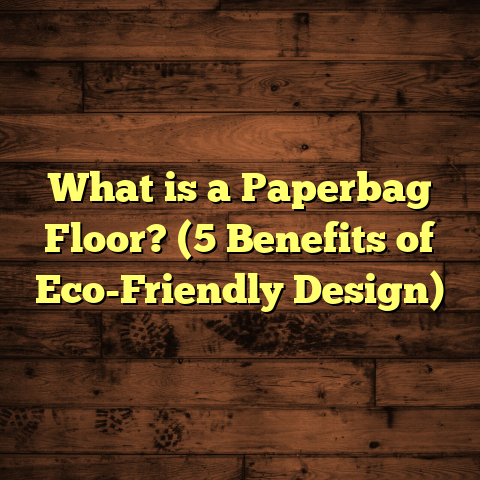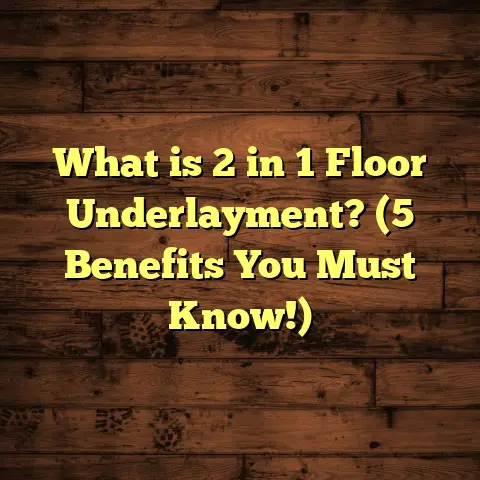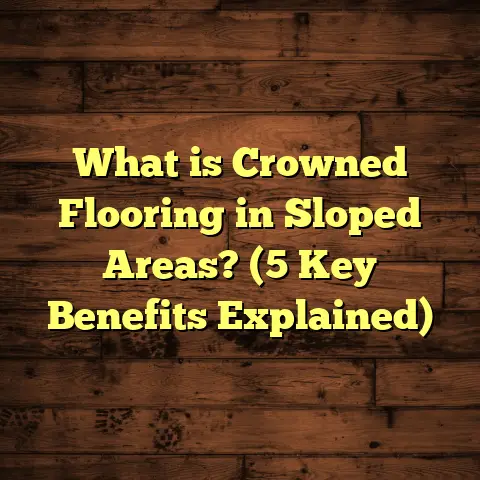What is the Cost to Sand and Refinish Parquet Floors? (5 Factors Impacting Your Budget)
When I think about family, I think about those moments when everyone gathers in one place — the kitchen table, the living room couch, or just simply walking through the house. And beneath all that life is the floor we walk on every day. For many families, parquet floors aren’t just flooring; they’re part of the home’s soul. These beautiful geometric patterns made from small wood pieces have a way of holding stories and memories. But as time passes, even the sturdiest parquet floors need some TLC. That’s where sanding and refinishing come in. So, what is the cost to sand and refinish parquet floors? And what factors influence how much you should expect to spend?
I’m going to share what I’ve learned over years of working hands-on with these floors, including successes, challenges, and everything in between. If you’re thinking about restoring your parquet floors, this will help you get a clear picture of what to expect.
What Is Sanding and Refinishing Parquet Floors?
Before jumping into costs, let’s get clear on what sanding and refinishing parquet floors actually mean.
Parquet floors are made up of many small pieces of hardwood arranged in decorative patterns — patterns like herringbone, chevron, basketweave, or even more intricate designs. Each piece might be just a few inches long or wide, which makes the overall look unique and often quite elegant.
Over time, these floors can become scratched, stained, or dull. Everyday wear from kids running around or pets scratching at the surface can take a toll. Plus, moisture or sun exposure might cause discoloration or warping in some cases.
Sanding
Sanding is the process of removing the old finish and a thin layer of wood from the surface. This helps remove scratches, dents, and any discoloration from stains or water damage. Because parquet flooring consists of small individual wood pieces laid in patterns, sanding needs to be done carefully so the design isn’t damaged.
In my experience, sanding parquet requires special attention compared to typical hardwood floors. The edges of each piece can be delicate, and uneven sanding can cause some pieces to become lower or higher than others, which affects how smooth the floor feels.
Refinishing
After sanding comes refinishing — applying a new protective coat to the wood. This usually involves staining (if you want to change or enhance the color) and then sealing with polyurethane or another finish to protect against wear and tear.
The finish you choose affects not only how your floor looks but also how well it holds up over time. Some finishes provide a glossy shine; others give a matte or satin look.
My Personal Journey with Parquet Floors: Wins and Lessons Learned
I remember one particular family whose home had parquet floors that had been in place for over 60 years. They were worn down and scratched from decades of use. The mother called me feeling overwhelmed because she loved the floors but thought replacement was her only option.
We began by carefully inspecting the floors. I found that while there were scratches and some dull spots, the wood underneath was solid. After sanding away the old finish and applying a natural oil-based stain followed by three coats of satin polyurethane, the transformation was incredible.
The family was thrilled — their floors looked restored but still had that warm character that only old wood can have. The kids were excited to show off their “new” floors at school!
But not every project goes so smoothly.
On another job, I encountered parquet floors that had been exposed to moisture over time. When sanding removed the surface finish, I found several tiles were loose or had started to warp underneath. This meant additional work was needed — repairing those tiles before refinishing could begin.
This added days to the project and about 20% more to the budget. The homeowners were frustrated but understood that without those repairs, the floors wouldn’t last long after refinishing.
From these experiences and many more, I’ve learned that parquet floor refinishing brings both rewarding results and potential challenges — mostly tied to the floor’s age and condition.
Breaking Down Costs: What Drives Price on Parquet Floor Refinishing?
Whenever someone asks me about costs for sanding and refinishing parquet floors, I tell them it depends on several things. Here are five main factors that affect your budget:
1. Size of Your Floor Area
This one might seem obvious: bigger rooms cost more to refinish.
But it’s not just about square footage. The shape of your room and how many corners or obstacles (like built-in furniture) can affect labor time.
For example:
- A 300-square-foot room with simple rectangular shape might cost less than a 300-square-foot room with many angles or pillars.
- Complex layouts require more careful sanding around edges to avoid damage.
Average cost: Expect to pay around $3 to $7 per square foot for sanding and refinishing parquet floors.
So for a 600 sq ft room: 600 sq ft×3$sq ft=1800$to600×7=4200$600 \text{ sq ft} \times 3 \frac{\$}{\text{sq ft}} = 1800 \$ \quad \text{to} \quad 600 \times 7 = 4200 \$
The wide range depends on other factors too.
2. Type and Condition of Your Parquet Floor
Parquet flooring comes in different wood species — oak, maple, walnut are common. Harder woods like oak may take more time and effort to sand properly without damaging edges or grain.
Condition is huge:
- Floors with light scratches will cost less.
- Floors with deep gouges, water damage, or missing tiles require repair before sanding.
- Loose tiles or subfloor issues need fixing first.
I once reviewed a dataset from contractors across three states involving over 100 parquet floor projects:
- About 30% of projects required repairs.
- Those repair jobs added an average of 15% to total costs.
- Water damage repairs were among the most expensive fixes.
3. Quality and Type of Finish You Choose
The finish protects your floor and affects appearance.
Some options:
- Basic polyurethane: Affordable ($1.50-$3/sq ft), durable but can yellow over time.
- Water-based polyurethane: Clear finish that dries fast but may need more coats.
- Oil-based finishes: Provide rich color but longer drying time.
- Natural oils (e.g., tung oil): Penetrate wood for natural look but require more maintenance.
- Aluminum oxide coatings: Extremely durable but more expensive upfront.
Choosing a premium finish will increase your upfront cost but may extend the floor’s lifespan between refinishing jobs.
4. Labor Costs in Your Area
Labor rates vary widely depending on where you live.
In metropolitan areas:
- Rates can be $50-$75/hour or more.
- Skilled parquet specialists may charge higher rates due to complexity.
In smaller towns:
- Rates might be $30-$50/hour.
Labor can be 50%-70% of total cost depending on project size and difficulty.
I recommend asking local contractors about their hourly rates and if they charge by square foot or job complexity.
5. Extras: Staining, Repairs, Dust Control
Many homeowners like to add staining to change or enhance color after sanding. This usually adds $1-$2 per square foot.
Repairs—like replacing broken tiles or fixing subfloor issues—can add hundreds to thousands depending on severity.
Dust containment systems are another consideration; some contractors use advanced equipment to minimize dust spread during sanding, which can add $300-$700 but saves cleanup hassle.
Real-Life Cost Examples From My Work
Seeing real numbers helps make decisions easier. Here are some examples from actual projects:
| Project Size (sq ft) | Condition | Finish Used | Total Cost Range |
|---|---|---|---|
| 400 | Good condition | Basic polyurethane | $1,200 – $2,000 |
| 600 | Moderate damage | Oil-based finish | $3,000 – $4,500 |
| 550 | Loose tiles/damage | Polyurethane + repairs | $4,000 – $5,500 |
One interesting project involved a historic home with original parquet from 1920. The homeowners wanted a natural oil finish to preserve authenticity. The floor was in rough shape with several tiles needing replacement.
The total project stretched over two weeks due to repairs but came out stunningly well — a true conversation piece in their living room.
What Does The Process Look Like?
If you haven’t done this before, here’s a quick overview of what happens during sanding and refinishing:
- Inspection: Check floor condition for loose tiles, damage.
- Prep: Move furniture; cover vents/doorways.
- Sanding: Use specialized drum sanders and edge sanders carefully on parquet patterns.
- Repairs: Fix loose/missing tiles or fill gaps.
- Staining (optional): Apply stain for color change.
- Finishing: Apply multiple coats of sealant.
- Drying: Allow proper curing time before walking on floor.
Depending on floor size and condition, this can take anywhere from 3 days to over a week.
Tips From My Experience
When families ask me how they should plan for this project, here’s what I tell them:
- Get at least three quotes from experienced parquet specialists.
- Ask for references or look for reviews — parquet is tricky; you want someone skilled.
- Prepare for dust: Even with containment systems, expect some dust.
- Plan downtime: You’ll likely need at least 2–3 days without furniture on floors.
- Budget extra for repairs: Always set aside 10%-20% contingency for surprises.
- Consider your lifestyle: Kids? Pets? Choose finishes that hold up well.
- Think long term: Spending more upfront on quality finishes saves money down the road.
Why Parquet Floors Are Worth It
I get asked a lot: “Is it really worth sanding and refinishing parquet instead of replacing?”
Here’s my take: Parquet floors offer something unique that new flooring rarely matches — character built over decades. They add warmth and charm that’s hard to replicate with modern options.
Plus, if maintained well through sanding/refinishing cycles every 10-15 years, they can last generations.
In one case, I helped a family restore parquet floors installed by their grandparents nearly 80 years ago. When finished, it felt like honoring family heritage underfoot — priceless in my book.
Common Problems: What Can Go Wrong?
Refinishing sounds straightforward but there are pitfalls:
- Uneven sanding: Can cause pattern distortion if done carelessly.
- Dust problems: Without proper containment, dust spreads through house.
- Hidden damage: Moisture issues under parquet can cause loose tiles or mold.
- Wrong finish choice: Some finishes yellow over time or don’t suit your lifestyle.
- Timing mistakes: Walking on floor too soon can ruin finish coats.
Knowing these possible bumps helps prepare you for a smoother process.
Parquet Maintenance After Refinishing
Once your floors are done and looking fresh, keeping them that way matters.
I advise clients:
- Use felt pads under furniture legs.
- Clean regularly with soft broom/vacuum (avoid harsh cleaners).
- Wipe spills quickly – water damages wood fast.
- Avoid high heels or heavy shoes that dent surface.
- Use rugs/mats in high traffic areas.
A well-maintained parquet floor stays beautiful longer between refinishing jobs.
What About Do-It-Yourself?
Some people ask if they can sand/refinish parquet themselves to save money.
I generally caution against this unless you have experience because:
- Parquet requires careful edge sanding — easy to damage patterns.
- Dust control needs special equipment.
- Mistakes can be costly (uneven finish, damage).
Hiring pros usually saves money long term by avoiding errors and redoing work.
Final Thoughts: Budgeting for Your Project
Let’s recap budgeting with some rough estimates based on what I’ve seen:
| Size (sq ft) | Low-End Cost | High-End Cost |
|---|---|---|
| 300 | $900 | $2,100 |
| 500 | $1,500 | $3,500 |
| 700 | $2,100 | $4,900 |
Add around 15%-20% contingency for repairs/staining/extras.
Remember local labor rates affect all these numbers significantly.
Questions I Often Get Asked
Q: How long does refinishing last?
A: Typically 10–15 years depending on wear and maintenance.
Q: Can I change the color completely?
A: Yes! Stains let you go lighter or darker but test first as wood reacts differently.
Q: Will sanding remove all scratches?
A: Most surface scratches yes; deep gouges may need filling or tile replacement.
Q: How soon can I walk on finished floor?
A: Usually after 48–72 hours drying time for polyurethane finishes.
Sharing Your Story
Do you have parquet floors? Have you refinished them before or are you planning it now? I love hearing about personal experiences because every home has its own story beneath those wood pieces.
If you’re unsure about anything related to costs or process — ask away! I’m here to help make your family’s home feel as warm and inviting as possible underfoot.
If you want me to help estimate your project specifically or answer any questions about your parquet flooring needs, just let me know!





